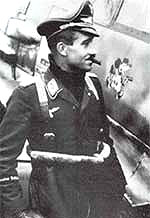

Flight of Eagles
by Robert Taylor
General Adolf Galland leading a swarm of Me109s from his famous JG26 “Schlageter” Fighter Wing, as they head out on an early morning patrol over Pas de Calais, 1941. All materials and methods used in the matting meet the highest conservation standards. Insured shipping is included for deliveries in the lower 48 states (a $100 value). For other deliveries please call for a shipping quote. |
| Overall size: 21⅞" x 25⅝" | SOLD |
| Archive Presentation | Signed by Adolf Galland - matted with four additional JG-26 pilot signatures |
| The signatures | ||
| Adolf Galland | Werner Molge | Heinrich Heuser |
| Heinrich ‘Jan’ Schild | Werner Kraft | |
Adolf “Dolfo” Galland was born on 19 March 1912 at Westerholt, Westphalia. At the age of 17 he started flying gliders, and began flying for Lufthansa after graduating from the German Commercial Air Transport School at Brunswick. In February 1934, he joined the Luftwaffe, by April 1935 he was a fighter pilot with Jagdgeschwader 2 “Richtofen”. In 1937, he volunteered for service with the Condor Legion in Spain. Galland was put in command of 3 Staffel of J/88, completing 280 combat sorties before being relieved by Werner Mölders in mid-1938. When World War 2 broke out Oberleutnant Galland was a Staffelkapitän of 4.(S)/LG 2 equipped with the Henschel Hs 123, a biplane Stuka. He took part in the invasion of Poland flying 50 ground attack missions. Galland was posted away to JG 27 at Krefeld, arriving there on 15 February 1940. He was assigned to the Geschwaderstab and assumed the role of Geschwader Adjutant. On 12 May, west of Liege, Belgium, he scored his first aerial victory. Two more victories followed that day. All three victims were RAF Hurricanes. By the end of the French campaign he had accumulated 14 victories. On 6 June 1940, Hauptmann Galland was appointed Gruppenkommandeur of III./JG 26. Promoted Major on 18 July, Galland stayed with III./JG 26 through the Battle of Britain. On 1 November 1940, Galland was promoted to Oberstleutnant and given command of JG 26. On 21 June 1941, Galland was shot down, by the Polish ace Boleslaw Drobinski of 303 Sqn, RAF, and baled out wounded. Galland had, by now, been ordered by Hitler and Göring not to fly combat missions. However, he disregarded these orders and continued to rack up aerial victories. On the death of Oberst Werner Mölders on 22 November 1941, Galland was named General der Jagdflieger. Before settling into his new job, Oberst Galland directed the fighter protection for the Channel dash of the battleships Scharnhorst and Gneisenau, and the heavy cruiser Prinz Eugen, from Brest. Galland became one of the most controversial figures of his time through his skirmishes with Reichsmarschal Göring and his frank addresses to Hitler when he emphasized the need for more fighters to oppose the increasingly intense allied bombing raids over Germany. Galland’s contemporaries in combat commands eventually began planning to force Göring’s resignation, by seeking an audience with Hitler. Although Galland took no direct part in such activities, Göring attributed the incipient mutiny to Galland, sacked him and prepared a trial. Hitler intervened but then insisted, as an end to the “Galland affair”, that he be given command of a unit of jet fighters. Galland led JV 44 until 26 April 1945 gaining up to seven victories flying the Me 262 jet fighter. On that day day he was bounced by a P-47 flown by 1st Lt James J Finnegan of the 50th Fighter Group, USAAF. Galland was wounded in the right knee and his aircraft received further damage. He was able to bring his crippled jet back to München-Reim and successfully land, but the wounds suffered in this encounter were serious enough to end his combat flying. Galland surrendered himself to American forces at Tegernsee on 5 May 1945. He was held in military custody for two years. He was released in 1947. Adolf Galland passed away on 9 February 1996 at Remagen-Oberwinter. Galland achieved 104 aerial victories in 705 missions, all on the Western front. Included in his
score are at least seven victories flying the Me 262. He was
himself shot down four times. |
 |
| Receive your print fully framed and ready to display. Please call or email us for a custom framing quote. |
 Adolf Galland
Adolf Galland